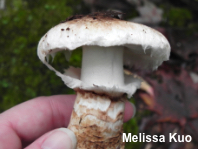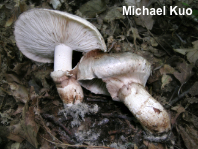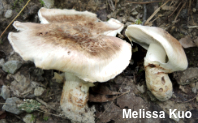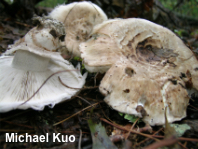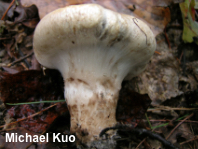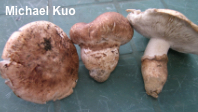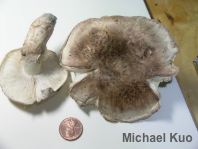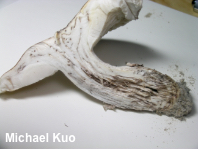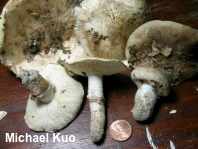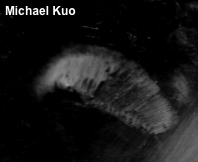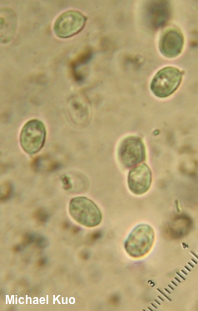| Major Groups > Gilled Mushrooms > Pale-Spored > Tricholoma > Tricholoma "caligatum" |

|
Tricholoma "caligatum" [ Basidiomycota > Agaricales > Tricholomataceae > Tricholoma . . . ] by Michael Kuo Tricholoma caligatum, without quotation marks, is a southern European and north African species associated with pines. I have not collected it—but I have collected what many North American authors have called "Tricholoma caligatum" (erroneously, it turns out) under hardwoods in eastern North America and the Midwest, and this is the mushroom described here. The booted stem is, I think, the coolest thing about Tricholoma "caligatum." Although the stem is white and naked at the top, just below the cap, its lower portion is sheathed with a brown to brownish veil that flares outward, forming a ring. The cap is brown and streaky-looking, like the booted part of the stem. The odor of the sliced flesh is not strong and distinctive, although it may be slightly fragrant, and the taste of the flesh ranges from bitter to mild. The North American "matsutakes," Tricholoma murrillianum, Tricholoma magnivelare, and Tricholoma mesoamericanum, are similar in appearance, but are easily separated on the basis of their pungent, distinctive, cinnamon-like odor and their association with conifers (or occasionally, in California, tanoak and madrone). I have collected a Colorado version of Tricholoma "caligatum," associated with spruce, nearly indistinguishable from the eastern North American, hardwood-associated version but lacking a distinctive odor or taste, and featuring a less streaked-looking cap and stem. Additionally, there is a California version of Tricholoma "caligatum"; according to Shanks (1994) it features a cinnamon-matsutake odor but tastes "extremely bitter." These versions, along with a few others, show separation in a preliminary DNA study (Ovrebo, Hughes & Halling 2009). In short, the caligatum group on our continent is in need of serious contemporary study and revision! Description: Ecology: Mycorrhizal with hardwoods, especially oaks; growing scattered or gregariously; fall; east of the Great Plains. The illustrated and described collections are from Kentucky and Illinois. Cap: 4–11 cm across; convex at first, becoming broadly convex or nearly flat; dry; streaked with brown over a whitish ground color; with age becoming somewhat fibrillose-scaly; the margin often adorned with fibrillose white veil material when young, and not becoming lined at maturity. Gills: Narrowly attached to the stem, or notched; close or nearly crowded; short-gills frequent; white to creamy, becoming a little yellowish or brownish with old age; when young covered by a white, fibrillose partial veil. Stem: 4–8 cm long; 1–2 cm thick; more or less equal above a tapered base; white and very finely shaggy-zoned above the ring; sheathed with a streaked to scaly brown covering below the ring; dry; ring sturdy, flaring, with a white upper edge and a brownish lower edge. Flesh: White in the cap but often grayish to gray in the stem with age; not changing on exposure. Odor and Taste: Odor not distinctive; taste bitter, or not distinctive. Chemical Reactions: KOH on cap surface negative. Spore Print: White. Microscopic Features: Spores 5–8 x 4–5 µm; ellipsoid to broadly ellipsoid; smooth; inamyloid; hyaline in KOH, often with a semirefractive globular inclusion. Basidia 4-sterigmate. Hymenial cystidia not found. Lamellar trama parallel. Pileipellis a cutis (occasionally an ixocutis); elements 5–7.5 µm wide, smooth, yellow-brown to brownish or hyaline in KOH. Clamp connections not found. REFERENCES: (Viviani, 1834) Ricken, 1915. (Kauffman, 1918; Smith, 1949; Thiers & Sundberg, 1976; Smith, 1979; Smith, Smith & Weber, 1979; Ovrebo, 1980; Weber & Smith, 1985; Arora, 1986; Breitenbach & Kränzlin, 1991; Phillips, 1991/2005; Shanks, 1994; Roody, 2003; Chapela & Garbelotto, 2004; McNeil, 2006; Binion et al., 2008; Ovrebo et al., 2009; Trudell & Ammirati, 2009; Bessette et al., 2013; Christensen & Heilmann-Clausen, 2013; Gulden et al., 2014; Kuo & Methven, 2014; Benazza-Bouregba et al., 2016; Baroni, 2017; Heilmann-Clausen et al., 2017; Woehrel & Light, 2017.) Herb. Kuo 10010407, 07250605, 10171201, 10081806. This site contains no information about the edibility or toxicity of mushrooms. |
© MushroomExpert.Com |
|
Cite this page as: Kuo, M. (2018, October). Tricholoma "caligatum." Retrieved from the MushroomExpert.Com Web site: http://www.mushroomexpert.com/tricholoma_caligatum.html |
